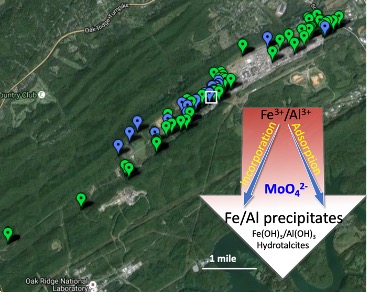Molybdenum limitation in the Oak Ridge Reservation contaminated environment, caused by iron and aluminum precipitation, affects nitrate reduction by microorganisms.

The Science
The Oak Ridge Reservation (ORR) in Tennessee is a uniquely acidic, high-nitrate- and high-metal-contaminated environment. Although nitrate can be removed by microbes living in this environment, a limited soluble Molybdenum (Mo) concentration in the ORR reduces biological denitrification. Two studies now reported the reason why Mo is limited and revealed the mechanisms used by some nitrate-reducing microbes to overcome Mo limitation and survive in these extreme conditions.
The Impact
Nitrate contamination has become a serious environmental problem—excessive amounts of nitrate in natural groundwater or soil cause many environmental and health problems. The metal Molybdenum (Mo) is essential for microorganisms to remove nitrate contamination from soils. Mo was found to be at deficient concentrations in the contaminated environment of the ORR. These insights explain why Mo is so limited in this area and how this affects nitrate-reducing microbial communities in these and other similar environments like acid mine drainage.
Summary
Mo availability is crucial for nitrate removal by the denitrification pathway in microorganisms. The soluble form of Mo is incorporated into the cell by a protein called Mod transporter. However, when Mo is found at a deficient concentration observed in the highly acidic and nitrate-contaminated wells in the ORR, microbial denitrification is largely inhibited. These studies proved that Mo limitation in the ORR groundwater results from incorporating soluble Mo into insoluble iron (Fe)- and aluminum (Al)-containing minerals. This mineralization process, called precipitation, occurs as the pH increases during the dilution of acidic and contaminated groundwater into the environment. These results show that Mo depletion by Fe/Al-precipitation can dramatically inhibit nitrate reduction by ORR microorganisms. Further evidence was found for direct Mo/Fe/Al-co-precipitation by analyzing contaminated sediment cores from ORR. A search for nitrate-reducing microbes in the Mo-limited area of the ORRf identified a metal resistant strain of Bacillus sp. named XG196. This strain was much less sensitive to Mo-limitation than other microbes from the same site. XG196 had the capacity to reduce nitrate under low Mo concentration because it contained a novel variant of the molybdate binding protein (ModA), which is part of the Mod transporter. XG196 ModA had a much higher affinity for molybdate than other ModA proteins previously characterized in other microbes. This protein variant not only has the highest Mo affinity reported so far, but it is also the first ModA to be characterized from a Bacillus strain.
Contact
Michael W. W. Adams
University of Georgia
adamsm@uga.edu
Publications
Ge, X., et al., “Iron‐and aluminium‐induced depletion of molybdenum in acidic environments impedes the nitrogen cycle.” Environmental microbiology 21(1), 152-163 (2019). [DOI: 10.1111/1462-2920.14435]
Ge, X., et al., “Characterization of a metal-resistant Bacillus strain with a high molybdate affinity ModA from contaminated sediments at the Oak Ridge Reservation.” Frontiers in Microbiology 11, 2543 (2020). [DOI: 10.3389/fmicb.2020.587127]
